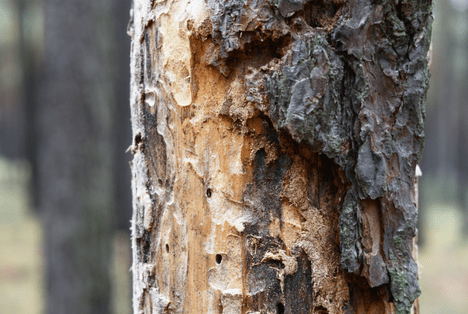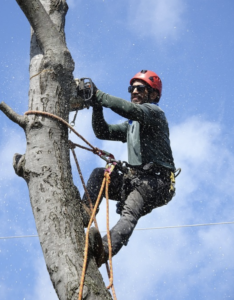How to Detect Infested Tree in Rhode Island
How Do I know if I got an infested tree?
A Guide to Tree Diseases by Rhode Island Tree Service, your local tree service in RI.

How to spot a diseased or an infested trees? This is an important question for homeowners and commercial property owners to consider, as infested tree might invite termites and other bothersome nuisances. Weakened, infested tree are also in jeopardy of shedding limbs or outright toppling, which can mean costly property harm and injury to anyone in the location!
To know if a tree is diseased, infested, or just stressed…
6 Common Signs of Poor Tree Health:
- Chewed or otherwise distorted leaves (infested tree leaves)
- Stunted foliage or leaf growth
- White spots
- Cottony white colored masses
- Gashes along the bark (infested tree bark)
- Stunted tree growing including twisting
Knowing if a tree is unhealthy and what all these indications reveal is the first step towards dealing with these troubles and keeping your tree in good health and strong. It’s also vital to know when a tree is beyond saving so you can plan tree removal services before it tips over or otherwise causes harm to your real estate.
A skilled arborist or tree services professional can inspect and figure if it’s infected and can be restored. Note some added details about common signs of an infested tree is unhealthy and how to address causes of disease and harm, and when it’s time to call in a specialist!
How to Recognize an Infested Tree?
A quick evaluation of your tree’s limb, branches, and leaves can quite often tell you if it’s diseased or otherwise needs some TLC. Consider a bit more information about typical signs of tree illnesses and then call an arborist or tree services contractor as required.
Chewed or otherwise distorted leaves
Small holes and jagged or otherwise uneven leaf edges often indicate pests and resultant disease. If you notice holes along a leaf front of what appears to be jagged leaf edges, call an arborist to check for infestation and needed treatment solutions.
Stunted foliage or leaf progression
Bugs and diseases sap a tree of moisture and nourishment, which results in stunted foliage or leaf progress. You might notice bare branches, dried-up leaves, or shrunken leaves on an unhealthy tree. If so, don’t assume you should simply cut those branches but call an arborist as soon as possible, to address that problem or other ailment.
Pearly spots on leaves and the tree itself
Scale insects are tiny white insects that drain a tree of its nutrients. These insects collect in masses that look like white spots on leaves and the tree itself. Washing off these insects helps protect the tree from further harm but that tree might also need some added attention to return to good health, including chemical treatment and better land irrigation.
Cottony white masses
Wooly aphids are sometimes mistaken for cotton growth or white mold on a tree. Similar to scale insects, you can wash off those aphids to protect a tree but it’s also crucial that a tree care expert check the tree’s health condition. He or she can note resultant harm and if the tree needs pruning or other care, and if the tree is totally free from an infestation.
Holes along the bark
Holes throughout tree bark often show wood-boring insects such as termites, or a lack of nutrients for the tree so that the bark cracks and breaks away. Those holes commonly give a nesting place for bothersome insects that lay eggs or alternatively tunnel into those spaces, making injury even worse over time. If you spot cavities in tree bark, call a tree service contractor today!
Stunted tree maturation including bending
Nonnative trees might have a hard time to develop in an inhospitable climate; a palm tree might struggle to grow in a chilly climate, for example. However, tree illnesses, root decay, and other conditions will stunt tree growth so that it’s oftentimes smaller than expected.
Weak or infested tree might also begin to sag, a

s a damaged or weak tree is not healthy enough to stand straight. Slanted trees are exceedingly dangerous as they might crack and then fall, so phone an arborist or tree care service for a full tree assessment, treatment, and needed bracing.
Can an Infested Tree Be Saved?
Like your own health, an infested trees can
often be saved depending on its situation and how swiftly you start treating it! Removing bug problems and correcting root rot, together with added fertilizing and bracing as necessitated, can enable a tree to grow healthy and tough once more.
In many cases, however, disease or pests may have ravished a tree so drastically that it’s beyond salvaging. Severe bark deterioration and reduction or large-scale infestation may affect a tree’s overall condition so that it can not restore that bark or produce fresh leaves.
Your real estate’s soil conditions also impact how properly a tree can regenerate; nutrient-rich soil feeds trees while strong ground allows it to stand tall and stay in a healthy condition. If your property’s soil is excessively moist or sandy or needing nutrients for any reason, a tree might strain to grow even with treatment.
How Can You Tell If a Tree Has Root Rot?
Healthy roots are firm and normally whitish in color. Soft brown roots, and specifically those that feel soggy to the touch, are usually rotted. Root rot also supports the growth of fungi along the roots, so you could see spores and other growth.
Roots take up water and nutrients from the soil; after roots rot, the tree then likewise struggles to mature and thrive. Leaves commonly wilt and fall away, and new leaves might not come into existence in the course of the tr
ee’s sprouting season. In extreme cases, the tree can die in just days or weeks of forming severe root rot!
Correcting root rot
Root rot is ordinarily the consequence of excessively hydrated soil. Properties with unsatisfactory drainage will oftentimes amass moisture around tree roots so that they then rot away.
It’s essential that you take a look at your property’s grade or slope, or supply needed drainage around the tree, before trying to address root rot. Soil should also be loose enough to allow proper airflow and oxygenation, and for roots to extend and develop through that soil.
Trimming away harmed roots and removing any fungi or other growths on the roots is also necessary, so that well-balanced roots can grow. To be sure you will not damage the tree or amputate too much root growth, call an arborist or tree care professional if you suspect a tree on your property deals with root rot.
What Does an Infested Tree Look Like?
Disease and pests are certainly not the only concerns for a tree on your property! A tree might be disease-free and not suffering an infestation, but still fighting to thrive. Inadequate dirt conditions, air pollution, prolonged harm to its trunk, and poor-quality trimming all influence a tree’s general condition and can easily lead to stunted tree growth. Signs of an unhealthy tree include:
- Bare areas along the trunk or branches
- Branches with no leaves or needles
- Fungus development around the trunk base
- Wilting
- Oozing sap
Healthy trees should show signs of progressing; this includes development along the trunk annually, filled foliage or healthy needles, an upright stance, and solid bark that stands up to peeling. If you do not observe these indicators or see any of the signs of an unhealthy tree listed above, call a tree care service or arborist close to you!
No Leaves, Does it Mean Death for the Tree?
Healthy and balanced, vivid leaves are a sign of a healthy, vibrant tree! No leaves, destroyed leaves, or otherwise irregular leaves are typically a sign of an unhealthy, damaged, or infected tree. Trees also have an expected life expectancy; lack of healthy leaves can suggest that tree is basically perishing of the equivalent of old age.
If your tree’s leaves are thinning or unusual at all, call a tree service company or arborist. Your property could need added hydration and watering for the tree to flourish. Correcting ailments or infestations can likewise enable a tree to grow healthy again.
An arborist or tree care company can also note the overall condition of a tree and if it’s dead or dying, or in danger of breaking limbs and toppling. In those cases, it’s generally recommended to schedule tree removal services.
Saving Your Stressed Tree
A stressed tree is usually salvageable, with a little TLC! In the event that the tree is native or otherwise able to flourish in your local area, keep in mind a few simple tips for encouraging healthy tree growth and saving a stressed tree.
Mature trees usually need about one inch of water each week, either from rainfall or irrigation, in order to grow. During the course of a dry season or if your property’s soil is overly dry, consider an irrigation system to provide the tree with sufficient hydration. Mulch may also help keep the soil replenished with water. Professional trimming is also key for saving a stressed tree. Trees expend energy supporting all their branches, including decaying or otherwise weakened limbs. Pruning those limbs away, as well as reducing overgrowth so a tree gets required sunlight and air circulation, assures a tree grows healthy and strong.
In addition, trimming is vital for tree well being, it’s just as significant that this work is handled by a pro! Wrong trimming strategies, including trimming limbs at the incorrect angle or trimming excessive branches, wounds trees and might do more damage than good. To ensure healthy tree growth, call a tree service contractor for needed pruning and trimming.
Can a Dead Tree Be Saved?
If a part of a tree is decaying or outright dead, you may be able to trim away that part of the tree and after that encourage healthy growth. Reversing reasons for decay, like pest treatment to remove an infestation, can also aid a stressed or drying tree to get healthy once again.
Even so, if a tree is outright dead, there is commonly no way to bring it back to life and good health. In that case, it’s optimal to get the tree eliminated before it begins to break and shed branches or fall outright.
Your comment is awaiting moderation.
How to improve your skills, essential for success.
team-building strategies for startups http://timetobuiseness.com/how-to-build-an-effective-team-for-your-new-business/ .